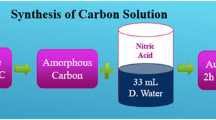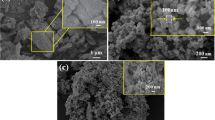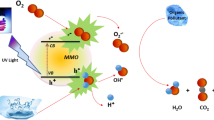Abstract
Water treatment is a worldwide problem that can be solved by the interaction of light with nanoparticles like WO3 nanoparticles. However, most nanoparticles have low photocatalytic efficiency in acidic conditions like acidic effluents of factories. Therefore, in the study, WO3 nanoparticles are synthesized with the sol–gel route as a simple and low-cost method, and then the nanostructures are calcined at a different temperature to find an effective photocatalytic agent for acidic water treatment. For the purpose, optical and structural properties, crystallinity, thermodynamic stability, and hydrodynamic diameter of the nanostructures are investigated in the paper. Raman and FTIR spectra of all four samples have approximately similar peaks and indicate the formation of WO3. XRD and thermal analysis point to a transition in the crystal phase with a change in calcination temperature. According to FESEM, DLS, and optical analyses, the as-synthesized and calcined WO3 nanoparticles @300 °C have the smallest particle size, the most stability in a liquid medium, and the best optical properties among other samples. The photocatalytic activities of these samples are evaluated via degradation of methylene blue, MB, (10 ppm) using irradiated WO3 NPs (20 ppm) under diode laser light with a central wavelength of 405 nm and the power of 100 mW. The high photocatalytic efficiency is obtained using the as-synthesized sample in both neutral (57.3%,) and acidic (74.7%) conditions and unlike most nanoparticles, the photocatalytic efficiency of the sample in acidic conditions is noteworthy, which makes it a suitable candidate for the treatment of acidic effluents in factories.

Graphical abstract












Similar content being viewed by others
References
Sung H, Ferlay J, Siegel RL, Laversanne M, Soerjomataram I, Jemal A, Bray F (2021) Global cancer statistics 2020: GLOBOCAN estimates of incidence and mortality worldwide for 36 cancers in 185 countries. CA Cancer J Clin 71(3):209–249
Aliannezhadi M, Minbashi M, Tuchin VV (2018) Effect of laser intensity and exposure time on photothermal therapy with nanoparticles heated by a 793-nm diode laser and tissue optical clearing. Quantum Electron 48(6):559
Jeevitha G, Abhinayaa R, Mangalaraj D, Ponpandian N (2018) Tungsten oxide-graphene oxide (WO3-GO) nanocomposite as an efficient photocatalyst, antibacterial and anticancer agent. J Phys Chem Solids 116:137–147
Elsayed EM, S Elnouby M, Gouda M, Elessawy NA, Santos D (2020) Effect of the morphology of tungsten oxide embedded in sodium alginate/polyvinylpyrrolidone composite beads on the photocatalytic degradation of methylene blue dye solution. Materials 13(8):1905
Han B, Popov A, Shekunova T, Kozlov D, Ivanova O, Rumyantsev A, Shcherbakov A, Popova N, Baranchikov A, Ivanov V (2019) Highly crystalline WO3 nanoparticles are nontoxic to stem cells and cancer cells. J Nanomater 2019:5384132
Zheng N, Zhang S, Wang L, Qi Z, Peng Q, Jian L, Bai Y, Feng Y, Shen J, Wang R (2022) Boosting image-guiding radiation therapy through W18O49 nanospheres and the second near-infrared light irradiation. Nano Res 15(3):2315–2323
Qureshi N, Lee S, Chaudhari R, Mane P, Pawar J, Chaudhari B, Shinde M, Rane S, Kim T, Amalnerkar D (2021) Hydrothermal Generation of 3-Dimensional WO3 Nanocubes, Nanobars and Nanobricks, Their Antimicrobial and Anticancer Properties. J Nanosci Nanotechnol 21(10):5337–5343
Rezaee O, Mahmoudi Chenari H, Ghodsi F (2016) Precipitation synthesis of tungsten oxide nanoparticles: X-ray line broadening analysis and photocatalytic efficiency study. J Sol-Gel Sci Technol 80(1):109–118
Yu J, Qi L, Cheng B, Zhao X (2008) Effect of calcination temperatures on microstructures and photocatalytic activity of tungsten trioxide hollow microspheres. J Hazard Mater 160(2-3):621–628
Derbasova N, Gavrish V, Oleynik A (2021) Studying the effect of monochrome light on the photocatalytic activity of tungsten oxide. J Phys Conf Ser 1:012117
Mohammed Harshulkhan S, Janaki K, Velraj G, Sakthi Ganapthy R, Nagarajan M (2016) Effect of Ag doping on structural, optical and photocatalytic activity of tungsten oxide (WO3) nanoparticles. J Mater Sci: Mater Electron 27(5):4744–4751
Khan MY, Ahmad M, Sadaf S, Iqbal S, Nawaz F, Iqbal J (2019) Visible light active indigo dye/graphene/WO3 nanocomposites with excellent photocatalytic activity. J Mater Res Technol 8(3):3261–3269
Deepa M, Kar M, Singh D, Srivastava A, Ahmad S (2008) Influence of polyethylene glycol template on microstructure and electrochromic properties of tungsten oxide. Sol Energy Mater Sol Cells 92(2):170–178
Ding R, Wang K, Hong K, Zhang Y, Cui Y (2019) Hierarchical core-shell tungsten oxide/TiO2 nanowires as an effective photocatalyst. Chem Phys Lett 714:156–159
Smrithi S, Kottam N, Arpitha V, Narula A, Anilkumar G, Subramanian K (2020) Tungsten oxide modified with carbon nanodots: Integrating adsorptive and photocatalytic functionalities for water remediation. J Sci: Adv Mater Devices 5(1):73–83
Sheikhi S, Aliannezhadi M, Tehrani FS (2022) Effect of precursor material, pH, and aging on ZnO nanoparticles synthesized by one-step sol–gel method for photodynamic and photocatalytic applications. Eur Phys J 137(1):60
Jamali M, Tehrani FS (2020) Effect of synthesis route on the structural and morphological properties of WO3 nanostructures. Mater Sci Semiconductor Process 107:104829
Ou P, Song F, Yang Y, Shao J, Hua Y, Yang S, Wang H, Luo Y, Liao J (2022) WO3· n H2O Crystals with Controllable Morphology/Phase and Their Optical Absorption Properties. ACS Omega 7(10):8833–8839
Jamali M, Tehrani FS (2021) Thermally stable WO3 nanostructure synthesized by hydrothermal method without using surfactant. Mater Sci Eng B 270:115221
Shariatmadar Tehrani F, Ahmadian H, Aliannezhadi M (2021) High specific surface area micro-mesoporous WO3 nanostructures synthesized with facile hydrothermal method. Eur Phys J 136(1):1–11
Tijani JO, Ugochukwu O, Fadipe L, Bankole M, Abdulkareem A, Roos W (2019) One-step green synthesis of WO3 nanoparticles using Spondias mombin aqueous extract: effect of solution pH and calcination temperature. Appl Phys A 125(3):1–12
Ahmadian H, Tehrani FS, Aliannezhadi M (2019) Hydrothermal synthesis and characterization of WO3 nanostructures: effects of capping agent and pH. Mater Res Express 6(10):105024
Abbaspoor M, Aliannezhadi M, Tehrani FS (2021) Effect of solution pH on as-synthesized and calcined WO3 nanoparticles synthesized using sol-gel method. Optical Mater 121:111552
Salmaoui S, Sediri F, Gharbi N, Perruchot C, Jouini M (2013) Hexagonal hydrated tungsten oxide nanomaterials: hydrothermal synthesis and electrochemical properties. Electrochim Acta 108:634–643
Tehrani FS, Ahmadian H, Aliannezhadi M (2020) Hydrothermal synthesis and characterization of WO3 nanostructures: Effect of reaction time. Mater Res Express 7(1):015911
Meng L, Zhao Z, Zhang M, Zhu X, Geng X, Liu J, Xia Y, Wang Z (2017) Synthesis of WO3 microfibers and their optical properties. Ceram Int 43(9):7048–7056
Shakya V, Pandey N, Misra SK, Roy A (2017) Electrical and optical properties of ZnO–WO3 nanocomposite and its application as a solid-state humidity sensor. Bull Mater Sci 40(2):253–262
Talukder A, Sultana P, Haider A, Wahadoszamen M, Abedin KM, Farhad S (2010) Power dependence of size of laser ablated colloidal silver nanoparticles. Eur Phys J D 60(2):295–300
Bahadori A, Dizaji HR, Memarian N, Aliannezhadi M (2020) Effect of preparation conditions on physical properties of manganese oxide thin films. J Sol-Gel Sci Technol 95(1):180–189
Gholizadeh Z, Aliannezhadi M, Ghominejad M, Tehrani FS (2022) High Specific Surface Area γ-Al2O3 Nanoparticles Synthesized by Facile and Low-cost Co-precipitation Method. preprint https://doi.org/10.21203/rs.3.rs-2085977/v1
Mioduska J, Zielińska-Jurek A, Janczarek M, Hupka J (2016) The effect of calcination temperature on structure and photocatalytic properties of WO3/TiO2 nanocomposites. J Nanomater 2016:3145912
Egorin A, Dran’kov A, Didenko N, Tokar E, Sokol’nitskaya T, Papynov E, Tananaev I (2020) Synthesis and sorption characteristics of tungsten oxides-based materials for Sr-90 removal from water media. J Mater Sci 55(22):9374–9384
Reis KP, Ramanan A, Whittingham MS (1992) Synthesis of novel compounds with the pyrochlore and hexagonal tungsten bronze structures. J Solid State Chem 96(1):31–47
Author information
Authors and Affiliations
Corresponding author
Ethics declarations
Conflict of interest
The authors declare no competing interests.
Additional information
Publisher’s note Springer Nature remains neutral with regard to jurisdictional claims in published maps and institutional affiliations.
Rights and permissions
Springer Nature or its licensor (e.g. a society or other partner) holds exclusive rights to this article under a publishing agreement with the author(s) or other rightsholder(s); author self-archiving of the accepted manuscript version of this article is solely governed by the terms of such publishing agreement and applicable law.
About this article
Cite this article
Abbaspoor, M., Aliannezhadi, M. & Tehrani, F.S. High-performance photocatalytic WO3 nanoparticles for treatment of acidic wastewater. J Sol-Gel Sci Technol 105, 565–576 (2023). https://doi.org/10.1007/s10971-022-06002-9
Received:
Accepted:
Published:
Issue Date:
DOI: https://doi.org/10.1007/s10971-022-06002-9




